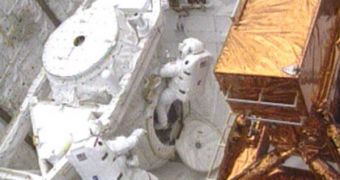Backgrounded by a pale blue Earth, Atlantis astronauts can be seen live in this NASA TV webcast of the American space agency while working on replacing the Wide Field Planetary Camera 2 (WFPC2) with the WFPC 3 instrument, which will boost the telescope's vision considerably. The replacement procedure is only the first task to be completed today, during the first spacewalk of the STS-125 mission to the aging telescope. The astronauts have had some problems with getting a few jammed bolts to open, so as to change the camera, but they finally managed to do it, and are, at the time of this article, in the process of pulling the old viewer out of its emplacement, and setting it aside.
The WFPC 3, which was stored in a special enclosure in the shuttle's cargo bay, has now been taken to the telescope by astronauts John M. Grunsfeld and Andrew J. Feustel, who make up the team for the first spacewalk of the mission. Also scheduled for today are a number of other tasks, including the attachment of a small docking bay to the telescope, which will ensure that a small, unmanned aerial vehicle is able to affix itself to the observatory, and gently push it off its orbit, when time for decommissioning comes. However, NASA engineers hope that Hubble will remain active until at least 2014, or maybe even long after that.
Making up Atlantis' crew are Commander Scott D. Altman, who will be in charge of the operations, Pilot Gregory C. Johnson, who will have to guide the spacecraft on the treacherous approach to the orbiting telescope, and also Mission Specialists Michael T. Good, K. Megan McArthur, John M. Grunsfeld, Michael J. Massimino, and Andrew J. Feustel.
During their 11-day mission, the seven astronauts aboard Atlantis will repair two of Hubble's instruments, install a new panoramic camera and a high-tech spectrograph, replace six of its gyroscopes, all of its batteries, and also add a new thermal insulation layer. The repairs will ensure that the telescope will remain active until at least 2014, making the most famous telescope in Earth's orbit even more competitive than before.
Experts also hope that the renewed telescope will be able to provide them with much-sought-after data on the most mysterious things in the Universe, such as dark matter and dark energy, which, together, make up the overwhelming majority of everything that exists in the Universe. It's estimated that the visible galaxies, gas, and dust in the Cosmos make up only four percent of its total mass, with another 22 percent accounted for by dark matter, and a whopping 74 percent made up of dark energy.
Over the next days, four additional spacewalks will be performed as well, completing a large variety of tasks assigned to the astronauts by mission control. NASA experts have deemed STS-125 as one of the most scientifically-complex missions ever carried out in space, on account of the huge workload and the short time the space experts will have at their disposal to get everything done.

 14 DAY TRIAL //
14 DAY TRIAL //